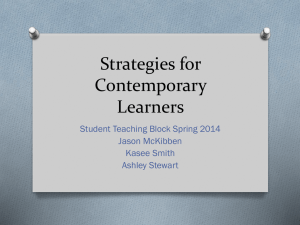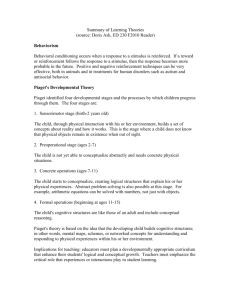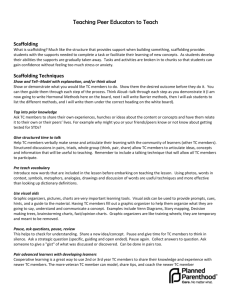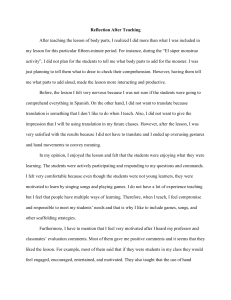Self-Reflections
advertisement
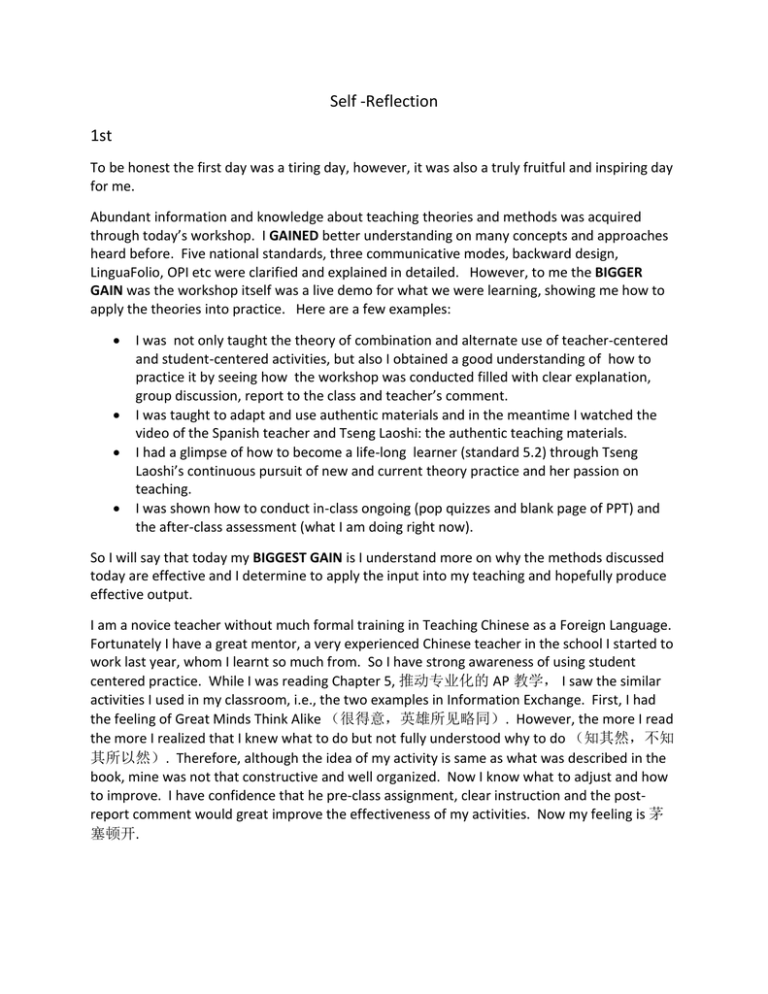
Self -Reflection 1st To be honest the first day was a tiring day, however, it was also a truly fruitful and inspiring day for me. Abundant information and knowledge about teaching theories and methods was acquired through today’s workshop. I GAINED better understanding on many concepts and approaches heard before. Five national standards, three communicative modes, backward design, LinguaFolio, OPI etc were clarified and explained in detailed. However, to me the BIGGER GAIN was the workshop itself was a live demo for what we were learning, showing me how to apply the theories into practice. Here are a few examples: I was not only taught the theory of combination and alternate use of teacher-centered and student-centered activities, but also I obtained a good understanding of how to practice it by seeing how the workshop was conducted filled with clear explanation, group discussion, report to the class and teacher’s comment. I was taught to adapt and use authentic materials and in the meantime I watched the video of the Spanish teacher and Tseng Laoshi: the authentic teaching materials. I had a glimpse of how to become a life-long learner (standard 5.2) through Tseng Laoshi’s continuous pursuit of new and current theory practice and her passion on teaching. I was shown how to conduct in-class ongoing (pop quizzes and blank page of PPT) and the after-class assessment (what I am doing right now). So I will say that today my BIGGEST GAIN is I understand more on why the methods discussed today are effective and I determine to apply the input into my teaching and hopefully produce effective output. I am a novice teacher without much formal training in Teaching Chinese as a Foreign Language. Fortunately I have a great mentor, a very experienced Chinese teacher in the school I started to work last year, whom I learnt so much from. So I have strong awareness of using student centered practice. While I was reading Chapter 5, 推动专业化的 AP 教学, I saw the similar activities I used in my classroom, i.e., the two examples in Information Exchange. First, I had the feeling of Great Minds Think Alike (很得意,英雄所见略同). However, the more I read the more I realized that I knew what to do but not fully understood why to do (知其然,不知 其所以然). Therefore, although the idea of my activity is same as what was described in the book, mine was not that constructive and well organized. Now I know what to adjust and how to improve. I have confidence that he pre-class assignment, clear instruction and the postreport comment would great improve the effectiveness of my activities. Now my feeling is 茅 塞顿开. 2nd Input plus interaction is the most optimal context for language acquisition. This gold rule is what I gained from today’s workshop and Van Patten’s Implications for Teaching. The meaningbased input, meaning-based interaction and meaning-based output play fundamental and critical roles in effective language acquisition and communication. Reflecting on my previous teaching and considering my future teaching, I would like to use BALANCE as my guide. Where is the balance point is the key point to explore. Balance of functional/communicative meaning and grammatical/structural features. I would like to focus on meaning rather than forms (the varieties of structure). A language is mainly served as the purpose for communicating, delivering and gathering some kind of meaning, like information and opinion. Meaning is the goal while forms are the carriers of the meaning. Balance of teacher centered and learners centered classroom. I would like to foster a level appropriate combination of teacher centered and learners centered classroom. Learners should be given ample opportunities to participate. Active interpersonal interaction will promote student to produce level appropriate output. Balance of varied authentic task. Tasks of real-life experience/ situations and the topic/ content related to the learners’ interests will stimulate learners’ intrinsic motivation and interests to learn. Task should be also level and age appropriate. Balance of using the three communicative modes. Each mode serves the different function of the communication. Balance of task requirement from the teacher and self-determine of the language resources by the learners. The teacher should provide specific and clear instruction but allow learners to selfdetermine language resources. Balance of scaffolding from the teacher and the do-it-yourself by the learners. Provide scaffolding as necessary to make language development within learners “zone of proximal development” (ZPD) which will push learners to a higher level of performance. Balance of the proficiency and accuracy. As by Van Patten, we should be mindful that the goals of fluency and strong output abilities are end of products of acquisition. 3rd Another refreshing and inspiring day! While listening, discussing and reading here at Startalk, I am keeping pondering on what I could take from here back to my own classroom in fall. It is excited that abundant information was gained, ranging from famous theories to detailed strategies. Here I would like to write down the following three reflections. In my writing yesterday, I appreciated our ancestor’s philosophy: to identify the point of balance and avoid going to the extreme. Dr. Ferree’s presentation today added one more thing I need to make balance in my classroom. In order to provide a relaxed and alert learning environment, students need to be at a status with proper stress. Neither the status with no stress nor that with too much stress will lead to good learning outcome. I used to be a chemist and using balance to weigh chemicals is a daily routine in my research. I fully understand how important it is to use exact right amount of each chemical in order to produce desired product. Teaching Chinese bears resemblance with making a new product in the lab. As over the dose of one chemical will lead to the failure of the experiment, over application of one task or activity will result in the ineffective teaching. Appropriate amount of something is the key to success and to find out the point of balance needs guidance from theory, theory and experiences of success and failure. The pictures of the young/old woman and the tiger stimulate me to think a lot. Looking at the same picture, somebody sees a young lady while others see an old woman. Looking at the same picture, most Americans focus on the tiger while most Chinese will pay attention to the information demonstrated in the whole picture. People might view the same object from the different angles and gain different information from it. Such reasons as the age, culture background, personal experience and the roles (teacher or student) attribute to this observation. As a teacher, I need to reflect my teaching from a student’s point of view. I need to frequently ask myself: Is the desired input appropriately interpreted by the students? Do the students perform as I expected? Is the teaching goal I set reached? This will help me to monitor the effectiveness of my teaching, and direct the way to modify, reshape or maybe total change the teaching strategies. How to Learn Teaching Techniques from Classroom Observation and Class Observation Checklist provide me guidelines and teaching strategies. Like using the Backwards Design strategy, I need to use the checklist to design and examine my teaching plan, implement and reflect my teaching process. We all know that it is much easier to say than to do. Through the challenging process of observing and being observed under the spotlight by Tseng Laoshi and so many other teachers, I expect I will go through the painful and awful stage and I hope I could feel awesome eventually. 4th To construct a good question for interpretive tasks will facilitate desired output. A good question should use i+1 principle, challenge but not discourage and intimidate students. The discussion in today’s workshop helps me to reflect my teaching and I realize that I need to ask myself the following questions when I construct questions for my students. Is the question meaningful? Is the question level appropriate? Is the question age appropriate? Is the question specific? Are the words and phrases level appropriate? What is the expected answer? Does it fulfill the goal of communication? Are there too many close ending questions? Does the question stimulate students to apply the language skills acquired? 5th I believe that an effective teaching is not only guided by the pedagogical theories and principles but is also greatly affected by the details of each step of the teaching plan and practice. Here are some points I am pondering. A body language or a facial expression could invite students to produce communicative output or become an intimidation to block the output. One extra input from the teacher might deprive students of a good opportunity to output. When a student says something wrong, a teacher might only need to recast the correct answer rather than repeat the wrong answer and tell the class it is wrong. Should a teacher show all the new words at the same time on one slide or allow one new word pop out at one time? Order change of one simple action might make difference. Giving out the worksheet first or modeling for pair/group work first? Changing one word might make the class flow much better and reduce the confusion. Ask the students to repeat after me “LiLaoshi’s birthday is July 1st “ rather than “My birthday is July 1st .” So details matter. My goal is through practice again and again with success and failure, all these effective strategies could become my second nature. 6th The importance of thorough consideration and repeated discussions One of the lesson objectives is the student is able to say their zodiac sign. Regarding how to introduce the sentence My zodiac sign is……, I pondered and also discussed a lot with a few teachers. Through the discussions for a few times, I had a chance to look at it from different angles. The way how native speakers usually address this topic in the natural communication environment, the level of some of the words and the structure of this course are considered. This inspired me greatly and was able to line up the ideas. The second issue I thought about a lot is how to introduce the 12 Zodiac animals in one class. I used a few strategies including separating the twelve animals into three sections, keeping on review and using PPT/soft toys of animals/printed out pictures of the animals. Before the class I was confident with the plan, the teaching flew well and the output of the student was satisfactory. The importance of appropriate scaffolding My second part is to teach I am…… years old. Unfortunately there is not enough scaffolding before the output is required. Therefore the students struggled with the output at first. How to handle the unexpected situation in classroom is also what I need to practice. The last part is to require the students to give their own and ask for a friend’s basic information, followed by presenting the information of the friend. What I learnt was for such a big task, step by step scaffolding is critical. Thanks Alice for the fruitful discussion the night before the class. 7th I believe that the effective student centered and communicative practice plays an important role in successful teaching and learning. In today’ class for dining, the last practice is a skit of ordering food in a Chinese restaurant. What I observed was even my original idea of the activity was both task-based and objectives-oriented, students could not fully take advantage of the practice and the outcome was not as good as expected. Through reflection, I realized what I need to adjust and improve the strategies in order to assist students to benefit to a higher degree from the practice. I should provide enough scaffolding, perform task analysis to break down a complex task into a few component parts, guide students step by step to reach desired performance level. My goal is to design appropriately challenging practice and activities, get students to engage confidently, be motivated and enjoy the learning. This will help students succeed and prevent students from developing academic and emotional problems. 8th The first part of the teaching plan is to review weather, time, places to visits, activities and food. The second part is an activity for making a plan for stay in Beijing for two or three days. The first part was designed very well. The practice flew well with reviewing the vocabulary and sentence patterns within twenty minutes and output of the students were highly satisfactory. Much effort was put on the discussion and plan of the second part. Finally an activity with proper scaffolding, inviting students to use what they acquired was designed. The outcome is fairly good and could be much better if more class time (another 20 minutes) is available. What I learnt is in order to design and carry out an effective activity, I could think thoroughly, intrigue students’ interests and provide the environment for students to output in target language.

